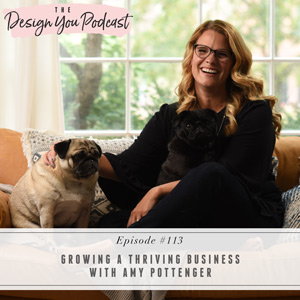
What a treat I have for you this week, friends! I have an amazing guest joining me – designer and online design coach Amy Pottenger. Amy helps mompreneurs everywhere beat the overwhelm and start showing up for themselves by creating a home that empowers them to live their best life. A member of my Design You coaching program, Amy joins me today to talk about everything she’s learned from the program and how she’s applied it to her own thriving design business. Pretty cool, right?
Amy joined the Design You program because she wanted to take her business from being a hobby to the next level. She tells us why adapting her mindset played a huge role in growing her business and how she learned to stop making excuses and get comfortable with being uncomfortable. As we say over in the community, discomfort is the currency of your dreams, and Amy is a fantastic example of the magic that can happen when you show up for yourself!
Join us this week to hear a real-life account of how Amy grew her business while learning that success comes from within. She’ll show us how analyzing her thoughts and behaviors enabled her to expand her business, and how she sees the current circumstances as a gift rather than an inconvenience. Whatever stage of your business you’re at, I have no doubt you’ll be inspired by her story!
If you are inspired by Amy and want to come and work with us in Design You – reach out! You can email me for one on one coaching or head over to my website for the Design You program. We’d love to have you be our next success story!
If you want to keep this conversation going, you have to join my free Design You Podcast community on Facebook. We have great conversations over there about the podcast episodes and our podcast guests are in there too! So head on over and I’ll see you there!





